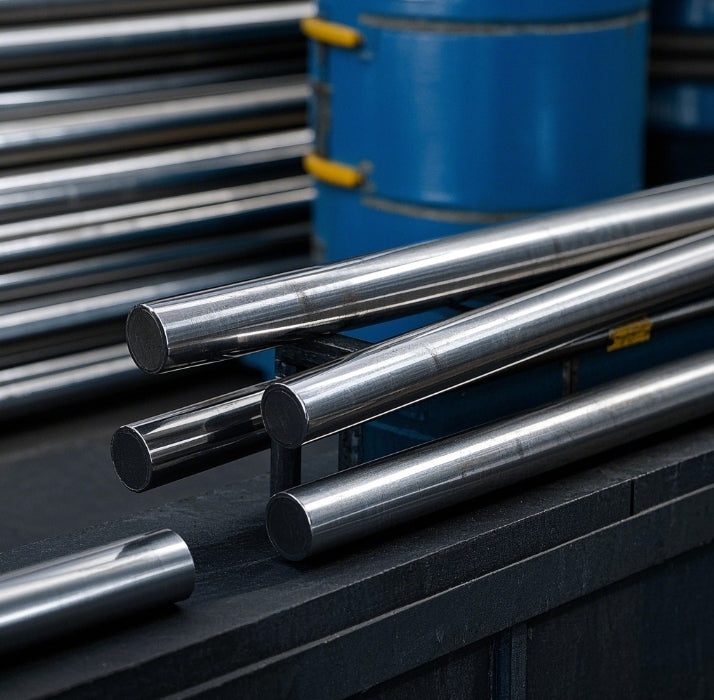StockSteel
Marine-Grade Stainless Steel Rods | High-Tensile Performance
Marine-Grade Stainless Steel Rods | High-Tensile Performance
Regular price
$1,250.00 SGD
Regular price
Sale price
$1,250.00 SGD
Taxes included.
Shipping calculated at checkout.
Quantity
Couldn't load pickup availability
Product Detail Page: Marine-Grade Stainless Steel Rods | High-Tensile Performance
Product Overview
Our stainless steel rods are engineered for demanding marine environments, combining high-tensile performance with exceptional corrosion resistance. Certified to ASTM A276, A479, and DIN EN 10088-3 standards, these rods are ideal for structural components, stainless steel fishing rod holders, and welding applications where durability in saltwater conditions is critical.
Technical Specifications
| Category | Details |
|---|---|
| Material Grades | 316L, 2205 Duplex, 304, 310S (Marine-grade optimized) |
| Diameter | 5mm–150mm (Custom sizes available) |
| Hardness (HRB) | 85-95 (316L: 88-93; 2205: 90-95) |
| Surface Finish | Polished, Pickled, or Cold-Drawn (Reduces friction and enhances corrosion resistance) |
| Length | 1m–6m (Cut-to-size options available) |
| Density | 7.9–8.0 g/cm³ (Varies by alloy) |
Key Properties
- Tensile Strength:
- 316L: 520–620 MPa | 2205 Duplex: 620–750 MPa.
- Enhanced by molybdenum (2.5–3.5% in 316L) and nitrogen (0.15–0.25% in 2205), these rods resist stress corrosion cracking in chloride-rich environments.
- Bend Strength:
- Retains structural integrity even under cyclic loading due to austenitic-ferritic microstructure in duplex grades.
- Identification Marking:
- Laser-etched codes (e.g., "316L-ASTM A479") for traceability and compliance with marine industry standards.
- Weight Calculation:
- Formula: Weight (kg) = (π × (Diameter/2)² × Length × Density).
- Example: 10mm × 1m rod ≈ 0.62kg (Density = 7.9g/cm³).
- Stainless Steel Rusting Causes:
- Chloride Exposure: Prolonged contact with seawater degrades passive oxide layers, especially in low-molybdenum grades like 304.
- Galvanic Corrosion: Occurs when stainless steel contacts dissimilar metals (e.g., aluminum) without insulation.
- Mechanical Damage: Scratches from improper handling expose raw steel to oxidation.
Applications
- Marine Construction: Hull reinforcements, railings, and stainless steel fishing rod holders.
- Welding: What rod is used to weld stainless steel to metal? ER309L or 316L filler rods ensure strong, corrosion-resistant joints between stainless steel and carbon steel.
- Offshore Platforms: High-strength 2205 rods for load-bearing components in harsh marine conditions.
Manufacturing Process
- Material Selection: Premium 316L/2205 billets with controlled sulfur content (<0.03%) for weldability.
- Hot Rolling: Reduces cross-section and refines grain structure.
- Cold Drawing: Enhances dimensional accuracy and surface finish.
- Solution Annealing: Heated to 1050°C (316L) or 1100°C (2205) for stress relief and corrosion resistance.
- Quality Assurance: Eddy-current testing for internal defects and spectrophotometric alloy verification.
Why Choose Our Stainless Steel Rods?
- Marine-Grade Certification: Compliant with NORSOK M-630 (offshore) and DNVGL-RP-0492 (shipbuilding).
- Corrosion Resistance: 316L rods withstand >1,000 hours in salt spray tests (ASTM B117).
- Custom Solutions: Precision-cut lengths for stainless steel fishing rod holders or bespoke marine fittings.
- Global Supply Chain: Stocked in EU, US, and Asia warehouses for fast delivery via DHL/FedEx.
- Technical Support: 24/7 guidance on welding parameters (e.g., TIG vs. MIG for what rod is used to weld stainless steel to metal).

